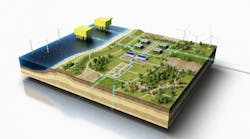Faced with rising complexity and pressure to deliver affordable and reliable power to customers, utilities must look to new technologies to improve their operations. Energy 4.0 technologies, such as the Industrial Internet of Things (IIoT), cloud computing, data and analytics, and artificial intelligence and machine learning (AI/ML) are already providing utilities with greater visibility, control, and monitoring of their substation assets and grid infrastructure.
Unfortunately, many utilities remain hesitant when considering the transition to cloud-based applications that harness the full capabilities of Energy 4.0 technologies. While some of these concerns can be legitimate reasons to turn to traditional on-premises infrastructure, most can be addressed so that utilities achieve the full benefits of these new and innovative solutions.
Cloud computing and cloud-based applications will become more prevalent in the coming years, and the utilities that embrace these new ways of doing things will be best positioned for long-term success.
This article is part of a series on utility cloud strategy and security. To learn more, read our white paper on Electric Energy Online : Don’t Fear the Cloud - Developing Cloud Security Policies for Remote Monitoring Applications.
What Is the Cloud?
At its simplest, cloud computing is the delivery of services through the Internet. This includes services such as data storage, servers, databases, networking, and software. Hardware and software reside offsite and are hosted, managed, and maintained by a cloud service provider, reducing the upfront infrastructure costs and generally offering greater security, resiliency, and performance than a smaller in-house system can provide.
We already use cloud-based services for both business and personal applications when accessing online email, collaborating on shared documents, or storing files on platforms such as Google Drive or Microsoft OneDrive. In the same way that these platforms allow you to securely access your files from any device, cloud-based applications allow utilities to collect, store, and use data from sensors and conduct detailed analysis to enable better operations & maintenance of critical infrastructure.
Why Choose the Cloud - The Benefits Over On-Premises Infrastructure
On-premises IT infrastructure, alternatively, is built, owned, managed, and controlled privately by the utilities. Data centers, servers, and other hardware are located on-site while software and applications are installed locally on each device.
While this approach does allow for greater control, the utility must also bear the full costs of procuring, deploying, maintaining, and upgrading the system over its entire lifecycle. Further, ancillary requirements, such as real estate and leases for data centers, procurement and storage of replacement components, and ongoing security updates and management, place additional strain on already thin internal IT departments.
Below are some of the key benefits of choosing a cloud-based strategy over a traditional, on-premises approach.
Lower Upfront Costs
Building an on-premises data center is expensive and requires a significant upfront capital investment. With the cloud, utilities simply pay to access resources on-demand without the burden or expenses associated with building and deploying on-premises infrastructure.
Greater Scalability
Demand for IT resources changes over time, but the capacity of on-premises IT infrastructure is generally fixed without making significant investments in new equipment.
The cloud, on the other hand, allows utilities to easily scale resources up or down in response to business requirements. This on-demand, pay-you-go model makes it easy to add new applications, sensors, facilities, or workloads as needed.
Fewer Maintenance Requirements
Because of their financial strategies, utilities tend to favor upfront capital investments over ongoing operating costs. On the surface, this can make an on-premises solution more attractive. However, managing, maintaining, and upgrading IT infrastructure still incurs significant operational costs and requires the hiring, training, and retention of highly skilled personnel, mitigating the apparent advantages.
In contrast, reputable cloud service providers handle these ongoing requirements on the utility’s behalf, reducing overall costs as well as the burden on the IT department.
Greater Security
Cybersecurity is rightly a concern for utilities, and cyberattacks have increasingly targeted the industry. In fact, the utility sector averaged 736 attacks per week in 2021, typically targeting industry control systems and seeking entry through the least protected links in the security architecture.
Despite this, most cloud providers offer more robust security than a typical on-premises system. Because of their size and the importance of security to their core business, cloud providers respond more effectively to emerging threats and build more security tools for users to protect their data.
Achieving the Benefits of the Cloud for Improved Operations
Energy 4.0 technologies are transforming how generation, transmission, and distribution infrastructure is managed, maintained, and modernized. Cloud computing and cloud-based applications provide utilities with greater visibility and control of critical grid infrastructure while reducing the overall cost of building, maintaining, and managing IT infrastructure.
In our next article, we’ll address some of the barriers to cloud-based applications and show how developing a strategic approach can help utilities implement and manage a wide range of solutions.
To learn more about the cloud and the strategic and security policies required for a successful implementation, read our white paper featured on Electric Energy Online: Don’t Fear the Cloud - Developing Cloud Security Policies for Remote Monitoring Applications
Richard Harada is Vice President Product Management & Marketing at Systems With Intelligence.



